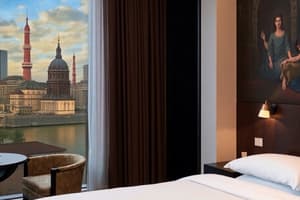Podcast
Questions and Answers
ما هو التركيز الرئيسي في تصميم المنطقة المؤدية إلى حمام السبا؟
ما هو التركيز الرئيسي في تصميم المنطقة المؤدية إلى حمام السبا؟
- تحيط المنطقة بالمساحات الخضراء النباتية للشعور بالهدوء.
- توفير تجارب فريدة مصممة خصيصًا لتفضيلات كل شخص. (correct)
- استخدام مواد قوية مثل الفولاذ المقاوم للصدأ والزجاج المقسى.
- التأكد من الوصول السهل إلى المنطقة من جميع أنحاء الفندق.
ما هو دور الإضاءة الخارجية في منطقة حمام السبا؟
ما هو دور الإضاءة الخارجية في منطقة حمام السبا؟
- استخدام عناصر مثل النور الطبيعي والمدافئ المريحة.
- استخدام مواد متينة للأثاث لتحمل زيارات كثيرة.
- تمديد استخدام المنطقة بعد ساعات النهار وإبراز ميزات مثل الشلالات. (correct)
- توفير مساحة كافية حول المسبح للكراسي والمظلات.
ما هي أحد العناصر التي يستخدمها مصممو جناحات الفخامة لإنشاء ملاذ شخصي للضيوف؟
ما هي أحد العناصر التي يستخدمها مصممو جناحات الفخامة لإنشاء ملاذ شخصي للضيوف؟
- الضوء الطبيعي. (correct)
- المفروشات الرخامية.
- الوصول السهل إلى منطقة الجناح.
- الإضاءة الخارجية.
ما هي أهمية مساحات حول حمام السبا؟
ما هي أهمية مساحات حول حمام السبا؟
كيف يعزز مصممو جناحات الفخامة تجربة الإقامة؟
كيف يعزز مصممو جناحات الفخامة تجربة الإقامة؟
ما هي أحد أهم الملاحظات لتصميم منطقة حول حوض السباحة في فنادق الفخامة؟
ما هي أحد أهم الملاحظات لتصميم منطقة حول حوض السباحة في فنادق الفخامة؟
ما المفتاح لإنشاء جو دافئ وراقي في تصميم اللوبي؟
ما المفتاح لإنشاء جو دافئ وراقي في تصميم اللوبي؟
ما دور المواد الطبيعية مثل الخشب والحجر في تصميم اللوبي؟
ما دور المواد الطبيعية مثل الخشب والحجر في تصميم اللوبي؟
ما أحد المكونات الرئيسية في تصميم المطعم؟
ما أحد المكونات الرئيسية في تصميم المطعم؟
ما دور الإضاءة الخافتة في تحقيق جو من الانسجام والودّ في المطعم؟
ما دور الإضاءة الخافتة في تحقيق جو من الانسجام والودّ في المطعم؟
لماذا تعتبر عزل الصوت مكونًا هامًا في تصميم المطعم؟
لماذا تعتبر عزل الصوت مكونًا هامًا في تصميم المطعم؟
لأي غرض يستخدم مصممي الفنادق المواد الطبيعية مثل الجلد والحجر في تصميم المسبح؟
لأي غرض يستخدم مصممي الفنادق المواد الطبيعية مثل الجلد والحجر في تصميم المسبح؟
Flashcards are hidden until you start studying
Study Notes
Luxury Hotel Design Basics: An In-Depth Guide
This comprehensive guide focuses on the essential aspects of luxury hotel design, specifically examining lobby, restaurant, suite, pool area, and spa area design. Each section provides insight into the key considerations and strategies employed to create stunning, cutting-edge properties that cater to the needs and desires of discerning guests.
Lobby Design
A well-designed lobby establishes the tone for the entire property and should evoke feelings of warmth and sophistication. Guests form lasting impressions upon entering, so it is crucial to strike a balance between comfort and functionality. With thoughtful coordination of furniture, lighting, and color schemes, designers can create an inviting atmosphere that fosters relaxation and inspires anticipation for the rest of the guest's journey. Consider incorporating natural materials like wood, stone, and leather, which convey an air of exclusivity and timeless elegance.
Restaurant Design
Restaurant design revolves around creating memorable dining experiences tailored to specific cuisines and themes. Key components include:
- Ambiance: Lighting, music, and artwork play vital roles in setting the mood. Soft ambient lighting invokes feelings of intimacy, while more vibrant illumination encourages socialization.
- Acoustics: Proper sound insulation ensures that conversations flow effortlessly during dinner without being disrupted by external noise.
- Ergonomics: Study of human comfort and capability to optimize dining chairs and tables for guests' comfort and accessibility.
- Durability: Choosing robust materials such as stainless steel, tempered glass, and high-quality linoleum or ceramic floorings that can withstand heavy foot traffic while maintaining their appearance.
Suite Design
Luxury suites should offer more than just additional space; they must provide unique experiences tailored to individual preferences. Designers use elements like natural light, cozy fireplaces, and customized artwork to create personal retreats for guests. Luxury amenities like automated curtains, climate control systems, and smart entertainment centers elevate the suite experience further. By combining aesthetics with functionality, designers can craft extraordinary spaces that offer unparalleled levels of comfort and indulgence.
Pool Area Design
Pool areas are essential components of many luxury hotels because they provide opportunities for relaxation and socialization. Key considerations include:
- Space: Allocate sufficient space around the pool for lounging chairs, tables, umbrellas, and other leisure activities.
- Accessibility: Ensure easy access to the pool area from both guest rooms and public spaces within the hotel.
- Landscaping: Surround the pool with lush greenery or elegantly designed seating arrangements to encourage a feeling of tranquility.
- Lighting: Proper outdoor lighting is necessary to extend use beyond daytime hours while also highlighting features such as waterfalls or fountains.
Spa Area Design
The spa is often considered one of the most crucial elements in any luxury hotel. To ensure it provides an immersive, rejuvenating experience, designers must focus on several aspects, including:
- Privacy: Create private zones where guests can unwind without distractions from outside noise or visual disturbances.
- Ambiance: Establish a peaceful atmosphere through soft lighting, calming colors, and soothing music to allow customers to fully relax.
- Hydrotherapy Area: Incorporate steam rooms, saunas, hot tubs, cold plunges, and experience showers to cater to various preferences and promote relaxation.
- Treatment Rooms: Construct modifiable treatment rooms equipped with comfortable massage beds, therapy couches, and storage space for essential oils or lotions.
By understanding these key components of luxury hotel design, owners can create exceptional properties that cater to their guests' desires while maintaining high levels of service and exclusivity. The result is an unforgettable experience that keeps guests returning time and again.
Studying That Suits You
Use AI to generate personalized quizzes and flashcards to suit your learning preferences.




